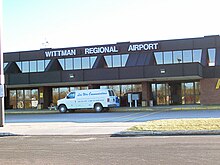Steve Wittman
Steve Wittman | |
|---|---|
| Born | Sylvester Joseph Wittman April 5, 1904 |
| Died | April 27, 1995 (aged 91) |
| Cause of death | Plane crash |
| Other names | "Witt" |
| Alma mater | Fond du Lac High School |
| Known for | Air Racing |
| Spouse(s) | Dorthy Rady, Paula Muir |



Sylvester Joseph "Steve" Wittman (April 5, 1904 – April 27, 1995) was an air-racer and aircraft designer and builder.
An illness in Wittman's infancy claimed most of his vision in one eye, which convinced him from an early age that his dream of flying was unattainable.[1][2] However, he learned how to fly in 1924 in a Standard J-1[3] and built his first aircraft, the Harley-powered "Hardly Abelson"[4] in late 1924. From 1925 to 1927, he had his own flying service, giving joyrides, and during this time also became a demonstration and test pilot for The Pheasant Aircraft Company and Dayton Aircraft Company, flying the Pheasant H-10 in multiple events. He also began his air-racing career, flying his first race in 1926 at a Milwaukee event in his JI.[1]
After competing in his first transcontinental air race from New York to Los Angeles in 1928, he attained a medical waiver on his eyesight[1] and received his pilot's license soon after (signed by Orville Wright).[5][1] He then went on to design, build and pilot his own aircraft, including Chief Oshkosh in 1931 and Bonzo in 1934. Wittman's first race in an aircraft design that was his was in "Bonzo", in the 1935 Thompson Trophy race, where he placed second.
In 1937, piloting his second homebuilt, "Chief Oshkosh", Wittman placed second in the Greve Trophy Race. Wittman flew "Bonzo" in the Thompson Trophy race, and he led for the first 18 laps of the 20 lap race, at an average speed of over 275 mph (442.57 km/h). Suddenly his engine began to run rough, and Wittman was forced to throttle back to remain in the race, finishing in 5th place. In 1938, he was awarded the Louis Blériot medal by the Fédération Aéronautique Internationale (FAI).
Also in 1937, Wittman designed and built "Buttercup". A high wing design built to outperform the Cubs, Chiefs, T-Crafts, and Luscombes of the day. Based on that aircraft, he built the Wittman Big X in 1945, and the popular Wittman Tailwind series of homebuilts.[6]
During World War II, his Wittman Flying Service was part of the Civilian Pilot Training Program, training pilots for the Army Air Corps.
After the war, Wittman finished eighth in the 1946 Thompson Trophy race with a clipped wing Bell P-63 Kingcobra fighter. In 1947, Bill Brennand won the inaugural Goodyear class race at the National Air Races piloting Wittman's 'Buster'. 'Buster' was a rebuild of the pre-war "Chief Oshkosh", went on to win many more Goodyear/Continental Trophy races, and was retired after the 1954 Danville, New York air races. It is now on display at the National Air and Space Museum in Washington, D.C.
Wittman built an entirely new 'Bonzo' for the 1948 National Air Races, and flying it himself, finished third. Wittman raced 'Bonzo' through the 1950s and 1960s, including the first few Reno National Championship air races, before retiring from Formula One competition in 1973. 'Bonzo' is now displayed next to Wittman's prewar 'Bonzo' in the EAA AirVenture Museum along with several other Wittman airplanes.
Wittman was manager of the Oshkosh, Wisconsin airport from 1931 to 1969 - which is now named after him (Wittman Regional Airport). Wittman became involved in the newly formed Experimental Aircraft Association in 1953 and was instrumental in bringing the EAA's annual fly-in to the Oshkosh Airport in 1970.
He designed and built the Wittman V-Witt to compete in the new Formula V Air Racing class. He competed in races with that aircraft until 1979. Winners of the Formula V National Championship are presented with the Steve Wittman Trophy.
Wittman remained active in aviation his entire life. For Wittman's 90th birthday a celebration, Wittman demonstrated aerobatic maneuvers in his V-Witt and Oldsmobile powered Tailwind. He also used "Buttercup" to give Young Eagles flights. Letters of appreciation were given by President Bill Clinton and Wisconsin Governor Tommy Thompson.[7]
Steve married Dorthy Rady in 1941. He taught her to fly and she accompanied him to most of his races. Dorthy died in 1991 and Wittman married Paula Muir in 1992. On April 27, 1995, Wittman and Muir took off for a routine cross-country flight from their winter home in Ocala, Florida to their summer home in Oshkosh, Wisconsin. The Wittman "O&O" N41SW (41 for 1941, year of his first marriage, plus SW, his initials) crashed five miles south of Stevenson, Alabama, killing both Wittman and Muir. The cause was improper installation of the wing fabric, causing it to debond, resulting in aileron/wing flutter.[8]
In 2014, Wittman was posthumously inducted into the National Aviation Hall of Fame.[9]
Wittman Designed Aircraft
- Wittman Hardley Ableson
- Wittman Chief Oshkosh
- Wittman D-12 Bonzo
- Wittman DFA "Little Bonzo"
- Wittman Buttercup
- Wittman Big X
- Wittman Tailwind
- Wittman V-Witt
References
- ^ a b c d Wisconsin Aviation Hall of Fame Inductee http://www.wisconsinaviationhalloffame.org/inductees/wittman.htm
- ^ National Aviation Hall of Fame inductee http://www.nationalaviation.org/wittman-sylvester-steve-j/
- ^ Sport aviation. November 2011.
{{cite journal}}: Missing or empty|title=(help) - ^ http://museum.eaa.org/collection/aircraft/Wittman%20Hardly%20Abelson.asp#TopOfPage
- ^ Sport aviation. August 2013.
{{cite journal}}: Missing or empty|title=(help) - ^ Jack Cox (July 1980). "Wittman Big X Restored". Sport Aviation.
- ^ Jack Cox (June 1994). "Happy 90th Steve". Sport Aviation.
- ^ National Transportation Safety Board
- ^ "Aviation Hall Of Fame Honors Six". Retrieved 23 December 2013.
